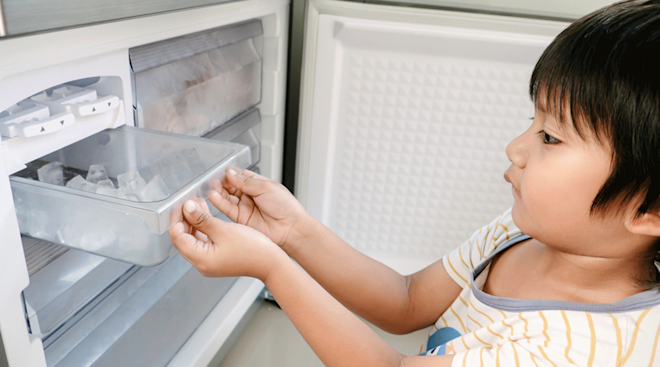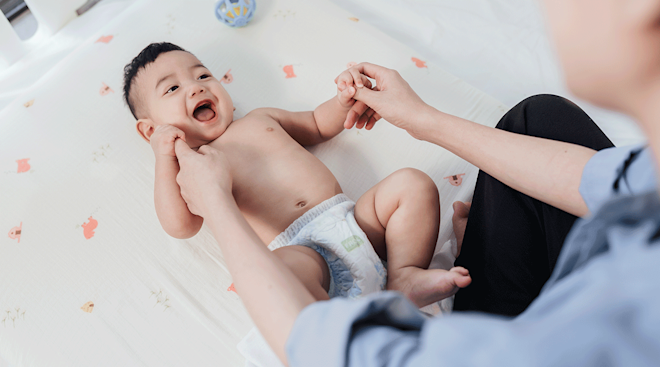How to Deal With Your Child’s Separation Anxiety
You’re not even out the door for work and the wailing has started. Or maybe the crying begins as you creep out of baby’s nursery after putting them down for a nap. Or perhaps you’ve only been out of your little one’s sight for a brief moment—say, to go to the bathroom. Whatever the trigger, if your absence causes your child to become hysterical, you may be dealing with separation anxiety. Read on to learn how to ease the tears (and finally pee without a chorus of cries in the background!).
So what is separation anxiety, exactly? Separation anxiety in children occurs when your child feels unsettled by a parent or caretaker’s absence. It can be downright distressing for parents, especially if your child is still a baby, but it’s no cause for alarm. “It’s perfectly natural for infants to become distressed when separated from a caregiver,” says Jessica Stern, PhD, a developmental psychologist and current research fellow at the University of Virginia. “In fact, infants’ instinct to cling to and resist separation from caregivers is important for their survival and healthy development.”
That’s because baby innately understands that they depend on caretakers to stay safe, and the loud crying is a way to keep Mom or Dad close by. You’re never leaving your little one in a dangerous situation—but they don’t know that, and want you back by their side!
Some children are naturally more prone to separation anxiety—perhaps due to a combination of genetics, temperament and environmental factors. For example, if you tend not to leave your child’s side (hey, parents can get separation anxiety too), then your tot may have a more difficult time staying at home without you for the first time compared with a child who has spent a lot of time with another caretaker.
The most obvious sign of separation anxiety is crying. Your child may start wailing as soon as you walk away and not stop until you get back. Other signs of separation anxiety—especially in infants—include clinging to you or not welcoming attention from other people.
As your child gets older, you may notice different signs of separation anxiety, such as:
- Refusing to go to school alone
- Refusing to go to sleep alone
- Requiring lots of attention from their parents
- Being extremely afraid of being left alone
- Crying and having tantrums when left with another caretaker
- Complaining of physical symptoms—such as a headache or stomachache—when separated from parents
Separation anxiety in infants typically starts when baby is about 9 months old, but the American Academy of Pediatrics (AAP) notes it could start as early as 4 to 5 months old. It depends on when babies start to understand the concept of object permanence—aka the fact that people and objects exist even when they’re out of sight. Once you disappear from view, a baby with separation anxiety can become distressed because they don’t know when you’ll come back.
“Normal separation distress typically calms by around age 2, when children learn that parents typically return after being out of sight,” Stern says. However, that’s not the case for all children, and it’s also possible for separation anxiety to develop later in life. Toddlers who were fine being away from their parents as a baby may start to show signs of separation anxiety around 15 or 18 months of age, for example. If your child’s separation anxiety does stick around after their second birthday, here’s some good news: It should go away for good by the time they graduate from preschool. However, in rare cases the anxiety may linger into later childhood.
First, don’t blame yourself. “Parents are not the cause of separation anxiety, but there’s a lot they can do to help it get better, or to prevent mild separation anxiety from becoming more severe,” says Eli Lebowitz, PhD, an assistant professor in the Child Study Center at Yale School of Medicine.
Next, figure out what’s normal and what’s not. “Normal clinginess is to be expected on the first day of school, after a child has been ill, following a move or other non-traumatic events,” Stern says. But if it begins to interfere with your or your child’s daily life, it’s time to do something. Here are some ways to ease separation anxiety in kids of all ages, the AAP notes:
• Time your goodbyes. Separations may be even more difficult for babies and toddlers who are tired or hungry. If you’re heading out, aim to wait until after your tot has eaten or napped.
• Make it quick. The more drawn out your goodbye is, the more time your child has to become anxious. Keep your leavings short and sweet—dole out a big hug and a kiss, maybe give your child their favorite blanket, and be on your way.
• Stay positive. Keep your goodbyes calm and cheery. If your child sees you’re upset to leave, it’ll only make things worse.
• Talk about your return. You can help ease separation anxiety in preschoolers by letting them know when you’ll be coming back—just make sure you use language they’ll understand. (“I’ll be back before snack time” or “I’ll be home after Grandma tucks you into bed.”) And make good on your promise, as this will help build your child’s trust and independence.
• Practice, practice, practice. If your child has separation anxiety, it may help to warm them up to the people you plan to leave them with—whether a family member or new babysitter. Have the caretaker over to the house so you can all spend time together, and keep your first separation on the shorter side.
• Cheer them on. If your usually anxious preschooler doesn’t cry when left with the babysitter, make sure to congratulate them on the milestone the next morning. “The goal with an anxious child is not to prevent them from ever feeling anxious, but to teach them that it’s okay to be anxious sometimes, and that the feeling will pass,” Lebowitz says. “Encouraging children to be brave and to cope, reinforcing and praising them when they cope better, and remaining empathetic in the times when they’re anxious are all important.”
If you have any concerns your little one isn’t getting over their separation anxiety—or if the extreme distress makes you unable to ever leave their side—talk to your pediatrician. They may recommend cognitive behavioral therapy or medication to address the issue, especially with older kids. With time, your child will learn that when you leave, you always come back.
Please note: The Bump and the materials and information it contains are not intended to, and do not constitute, medical or other health advice or diagnosis and should not be used as such. You should always consult with a qualified physician or health professional about your specific circumstances.
Plus, more from The Bump:
Eli Lebowitz, PhD, is an assistant professor in the Child Study Center at Yale School of Medicine. He earned his medical degree from the Yale University School of Medicine and his PhD from Tel Aviv University.
Jessica Stern, PhD, is a developmental psychologist and current research fellow in the department of psychology at the University of Virginia.
American Academy of Pediatrics, How to Ease Your Child’s Separation Anxiety, July 2021
Learn how we ensure the accuracy of our content through our editorial and medical review process.
Navigate forward to interact with the calendar and select a date. Press the question mark key to get the keyboard shortcuts for changing dates.




















































